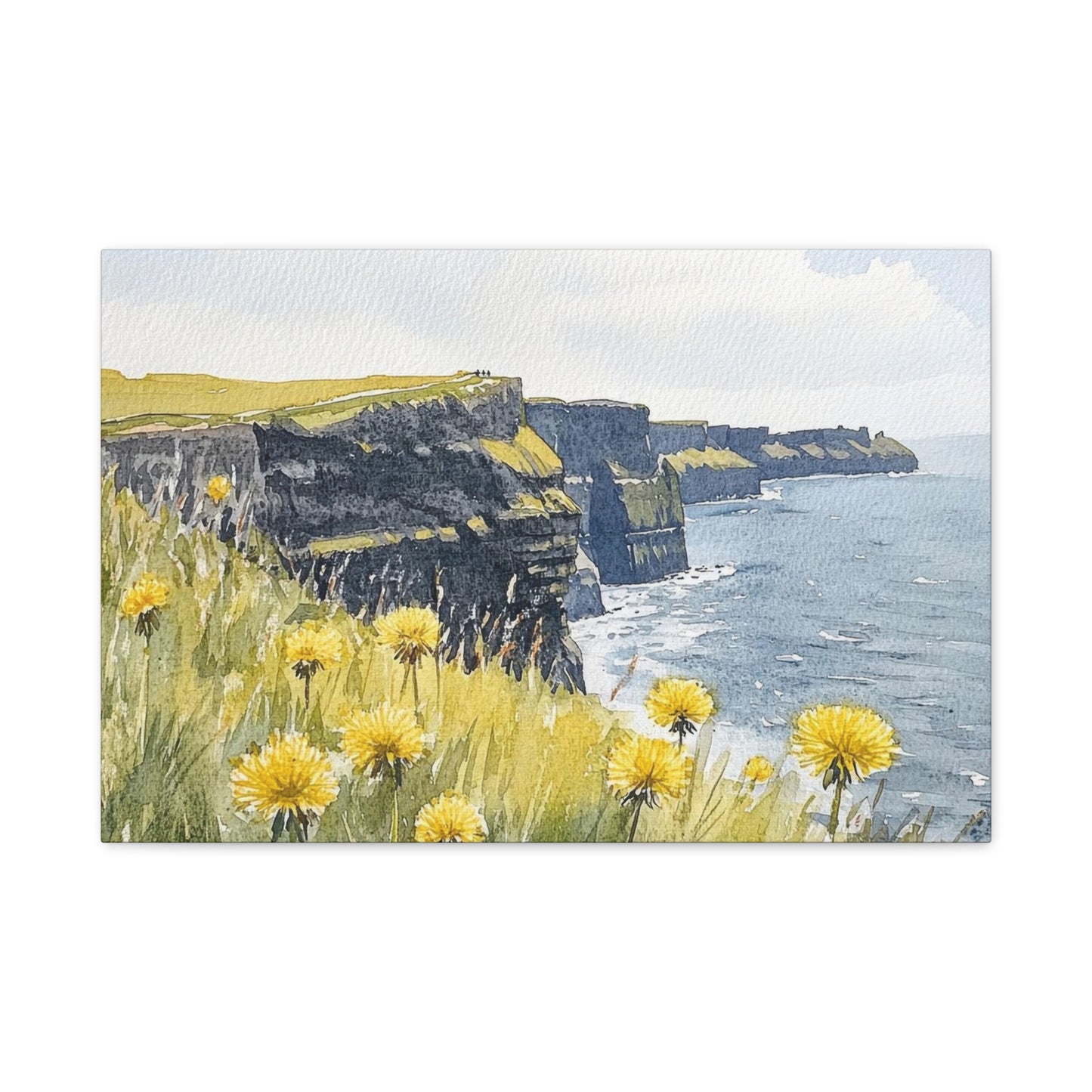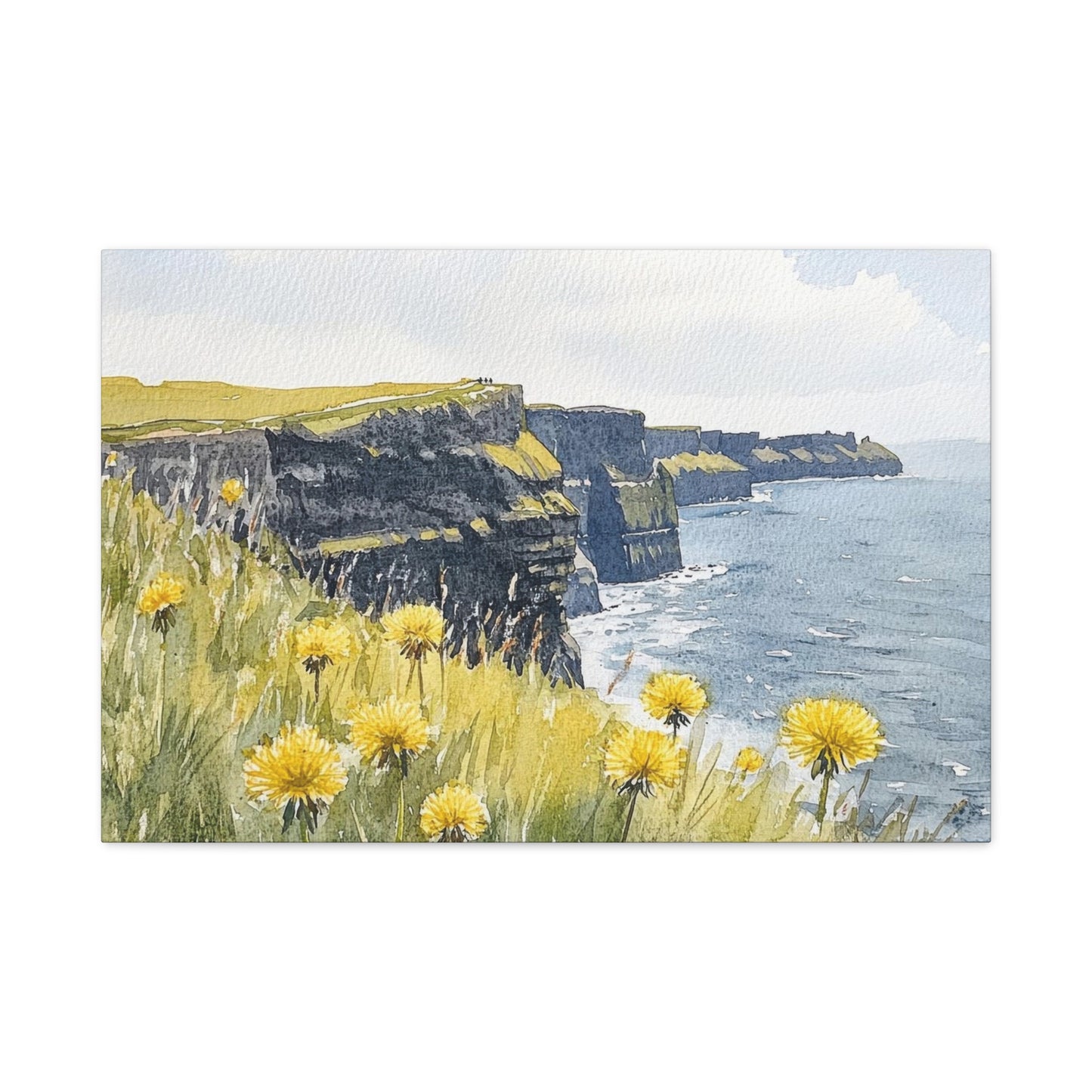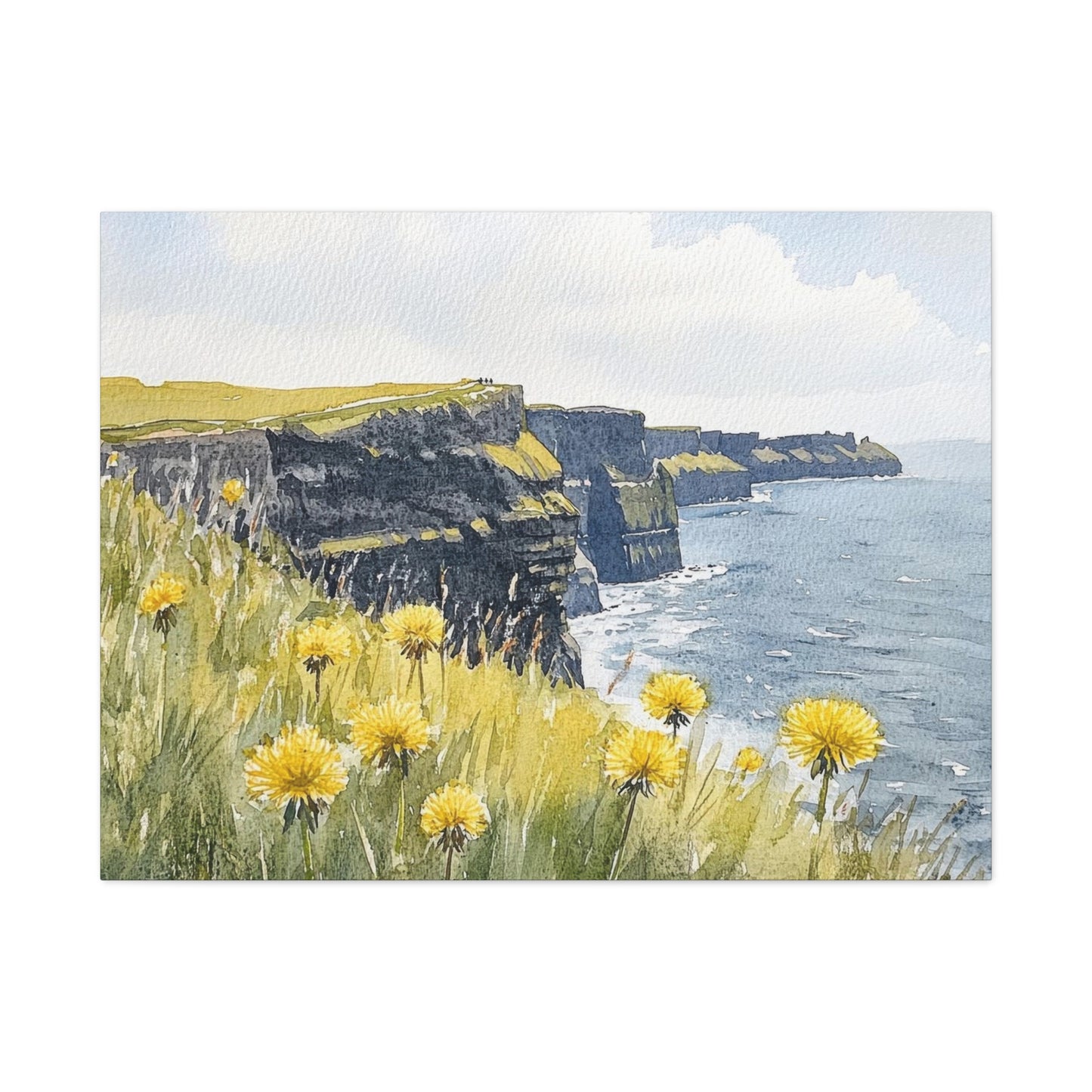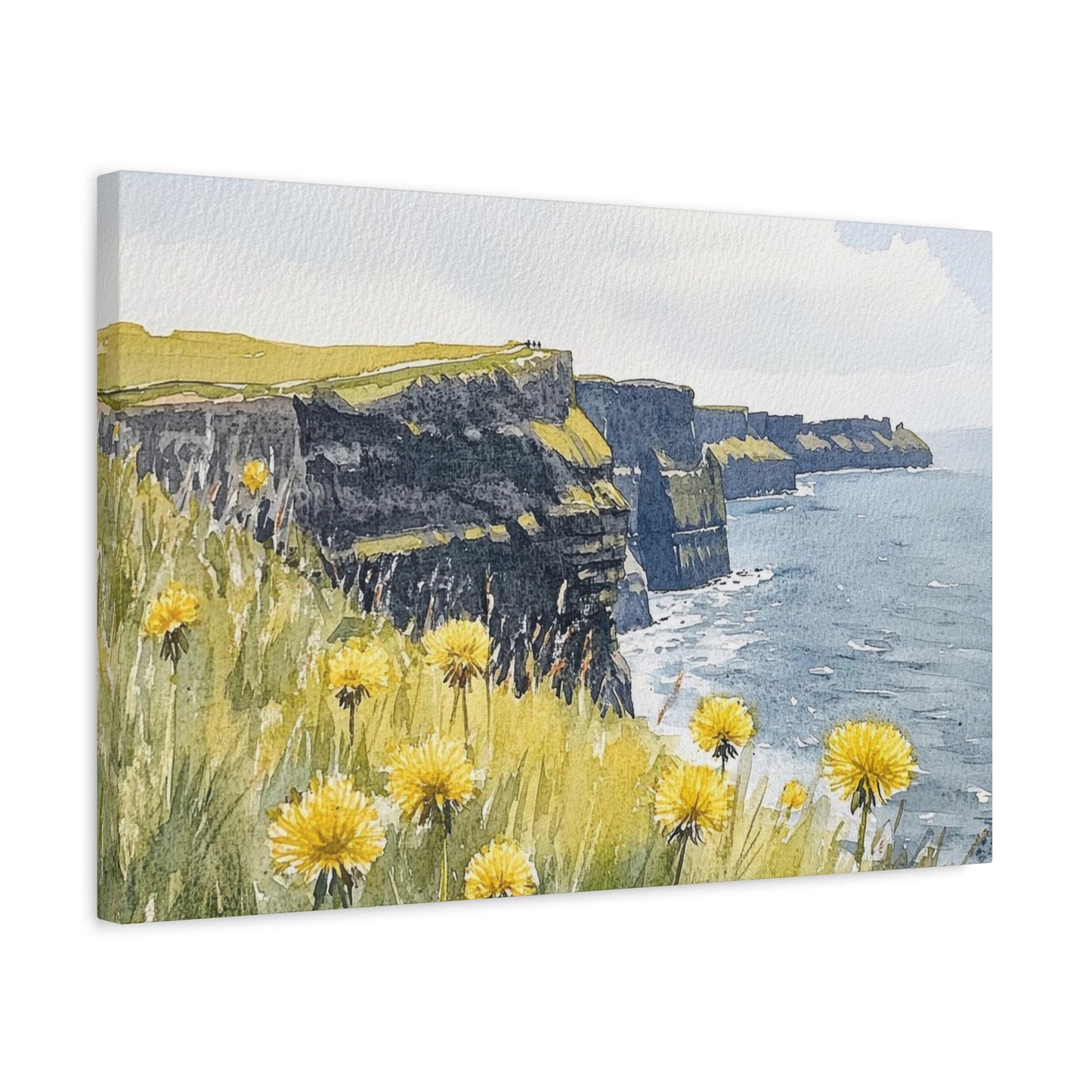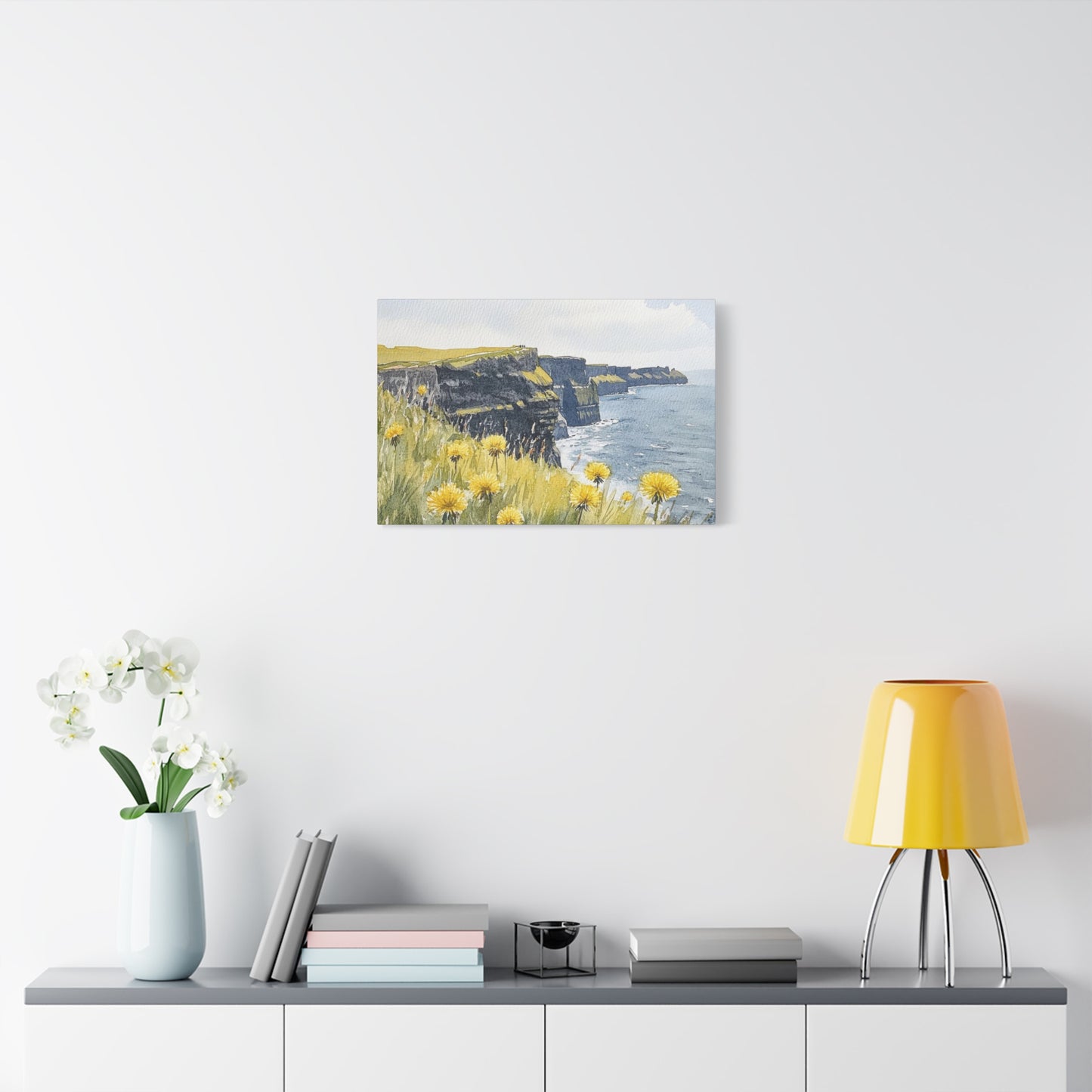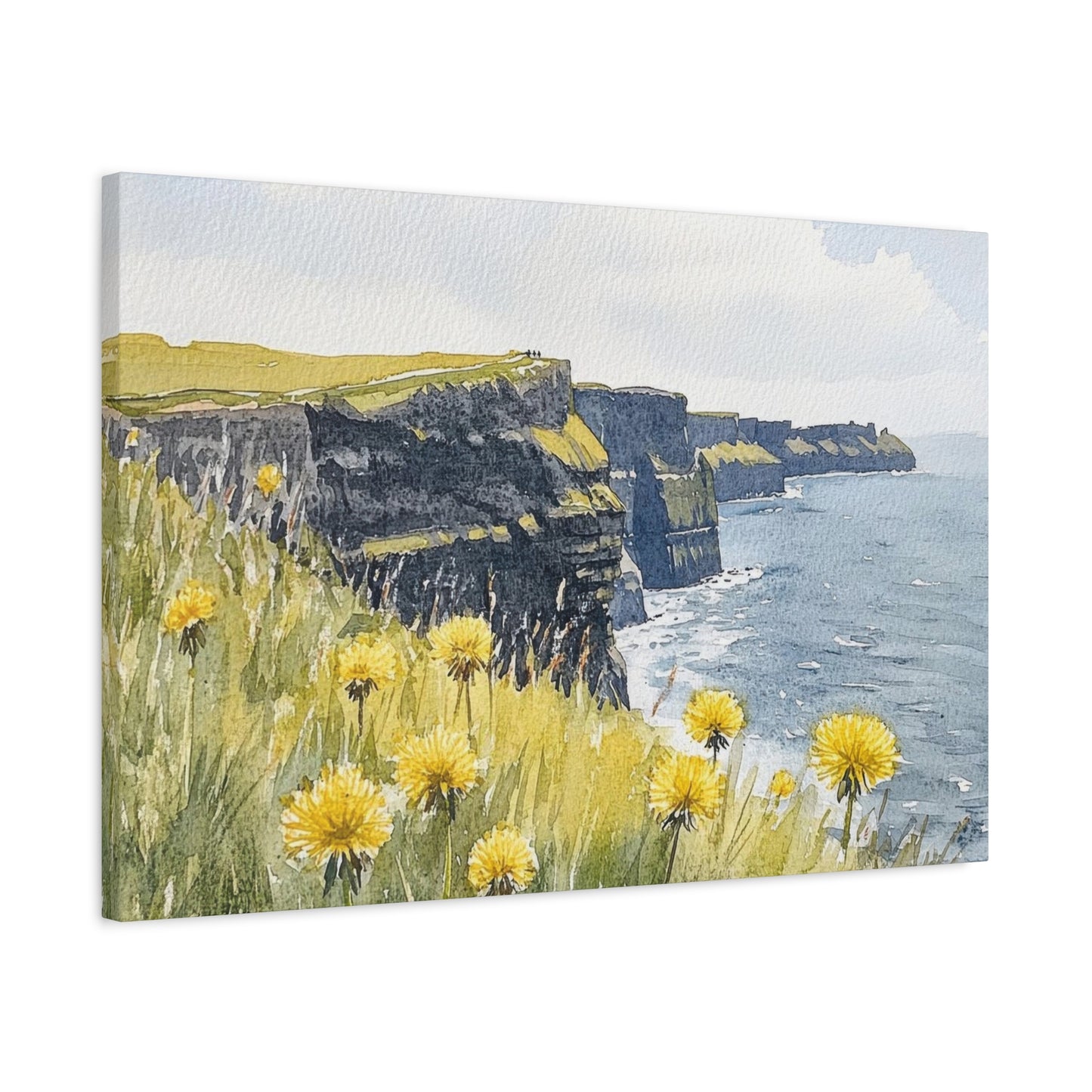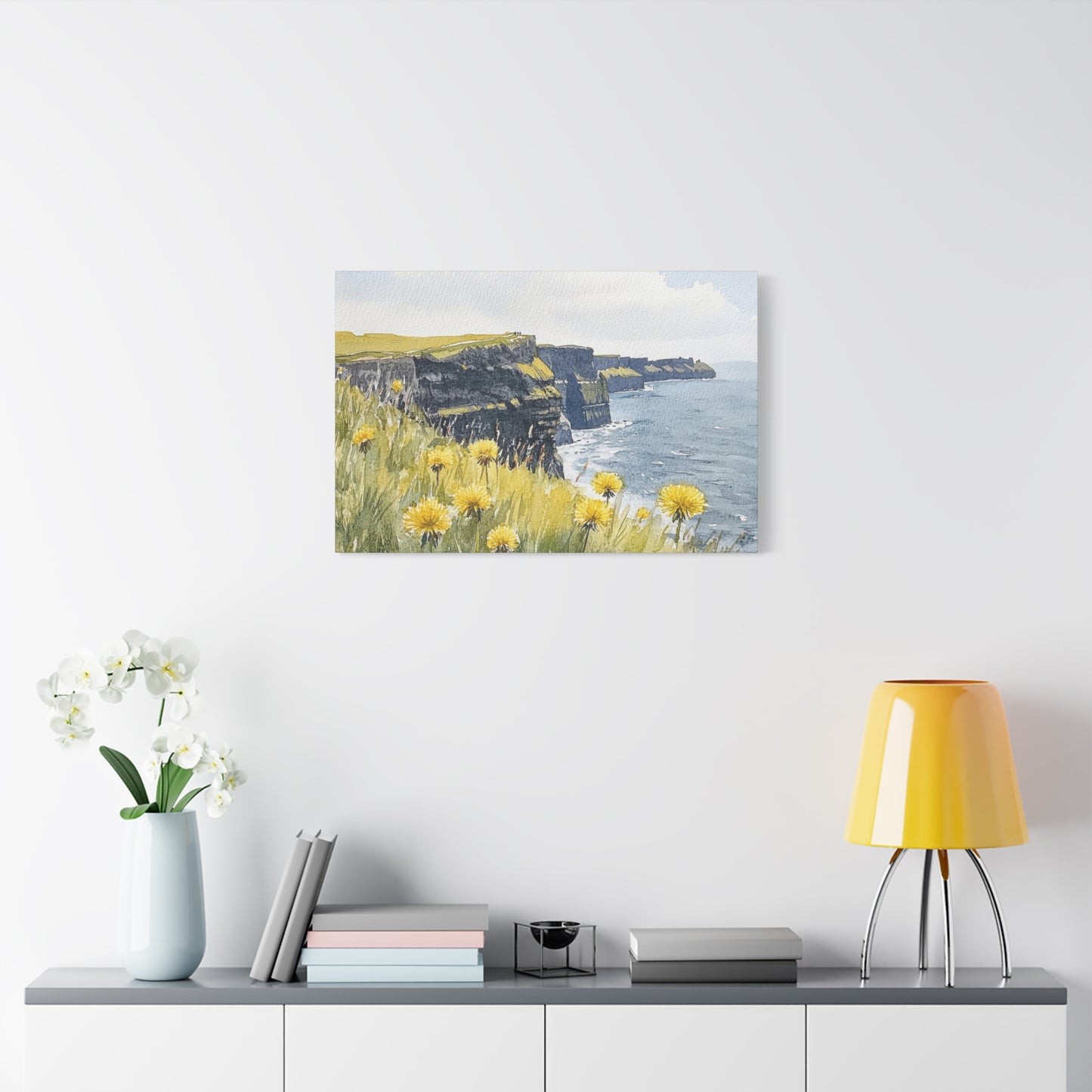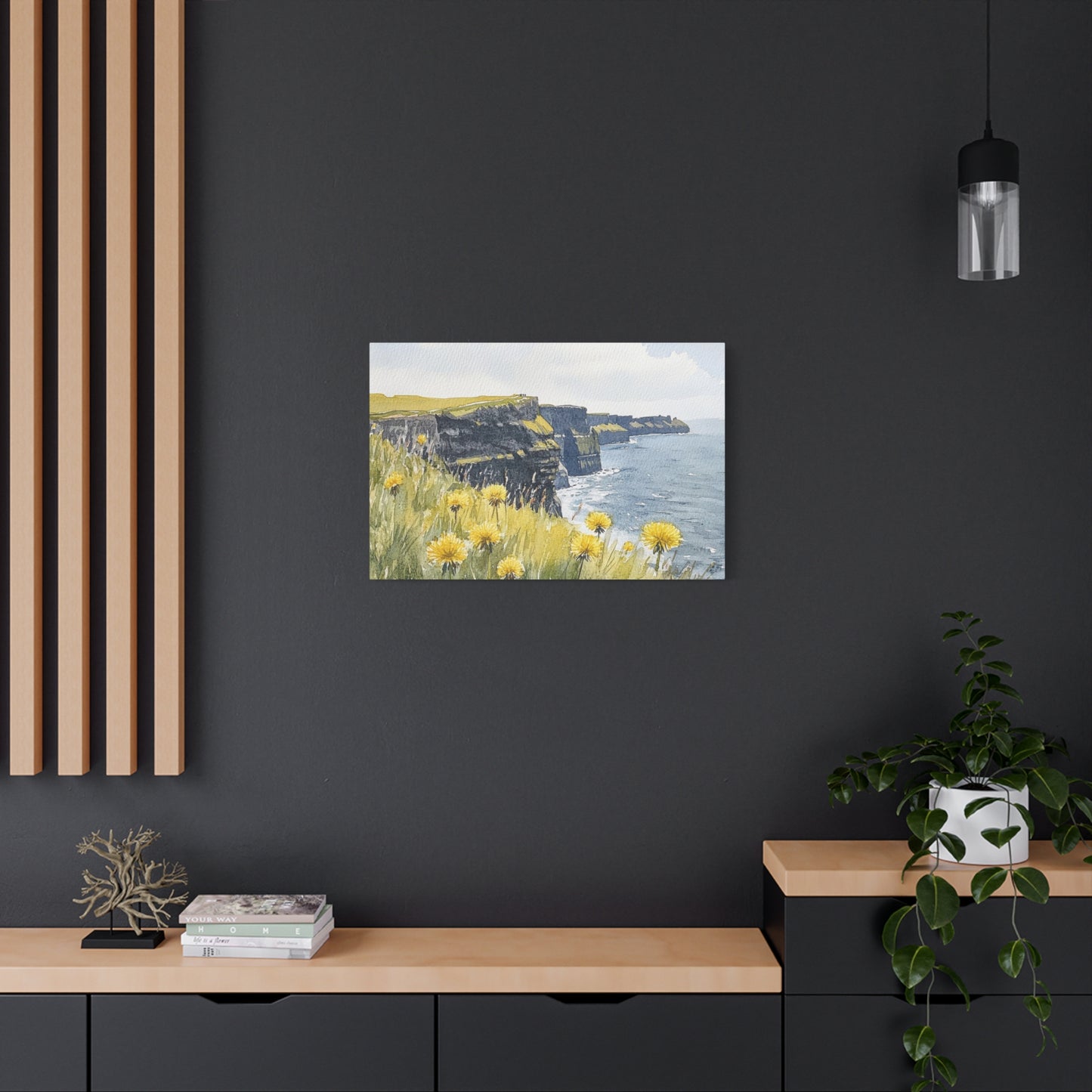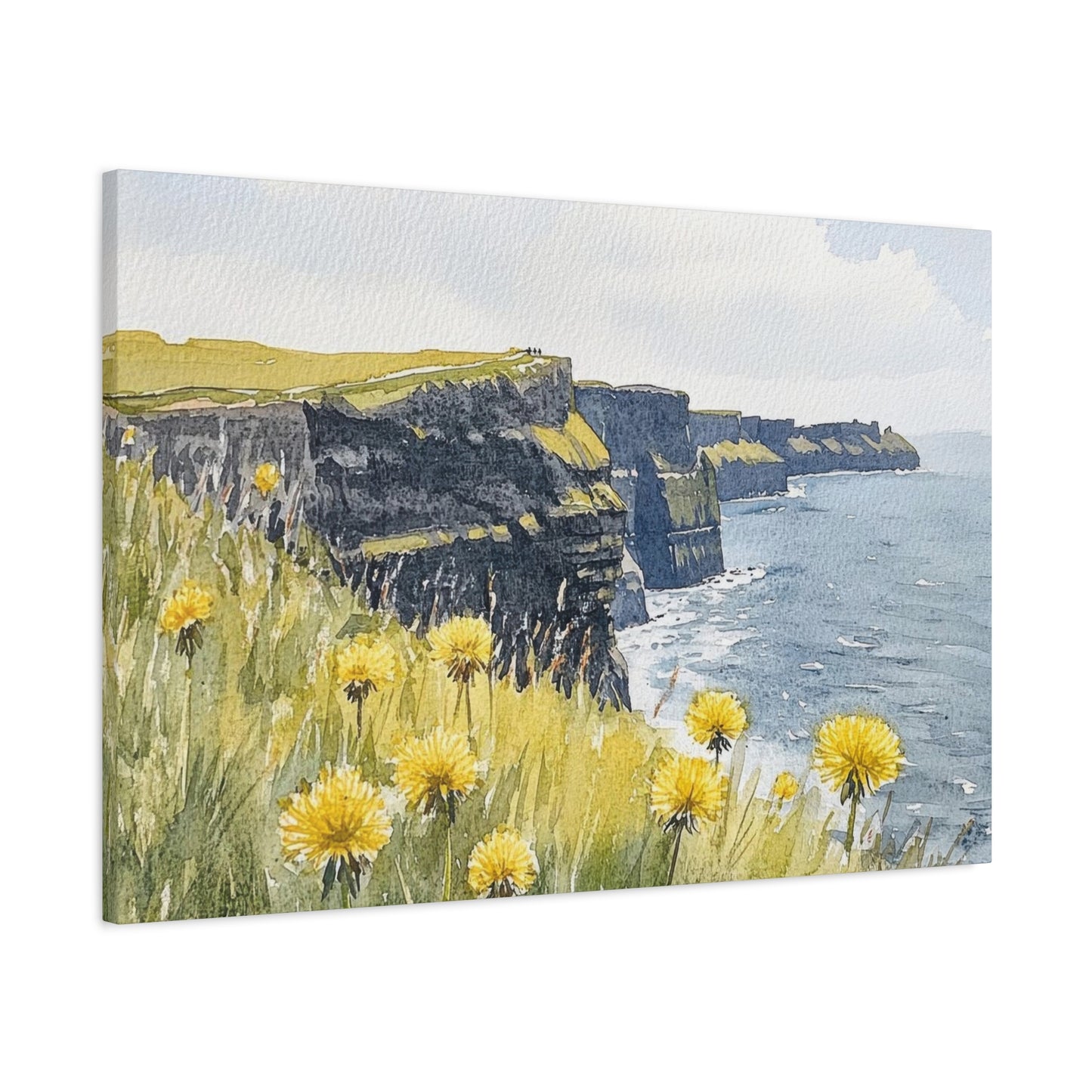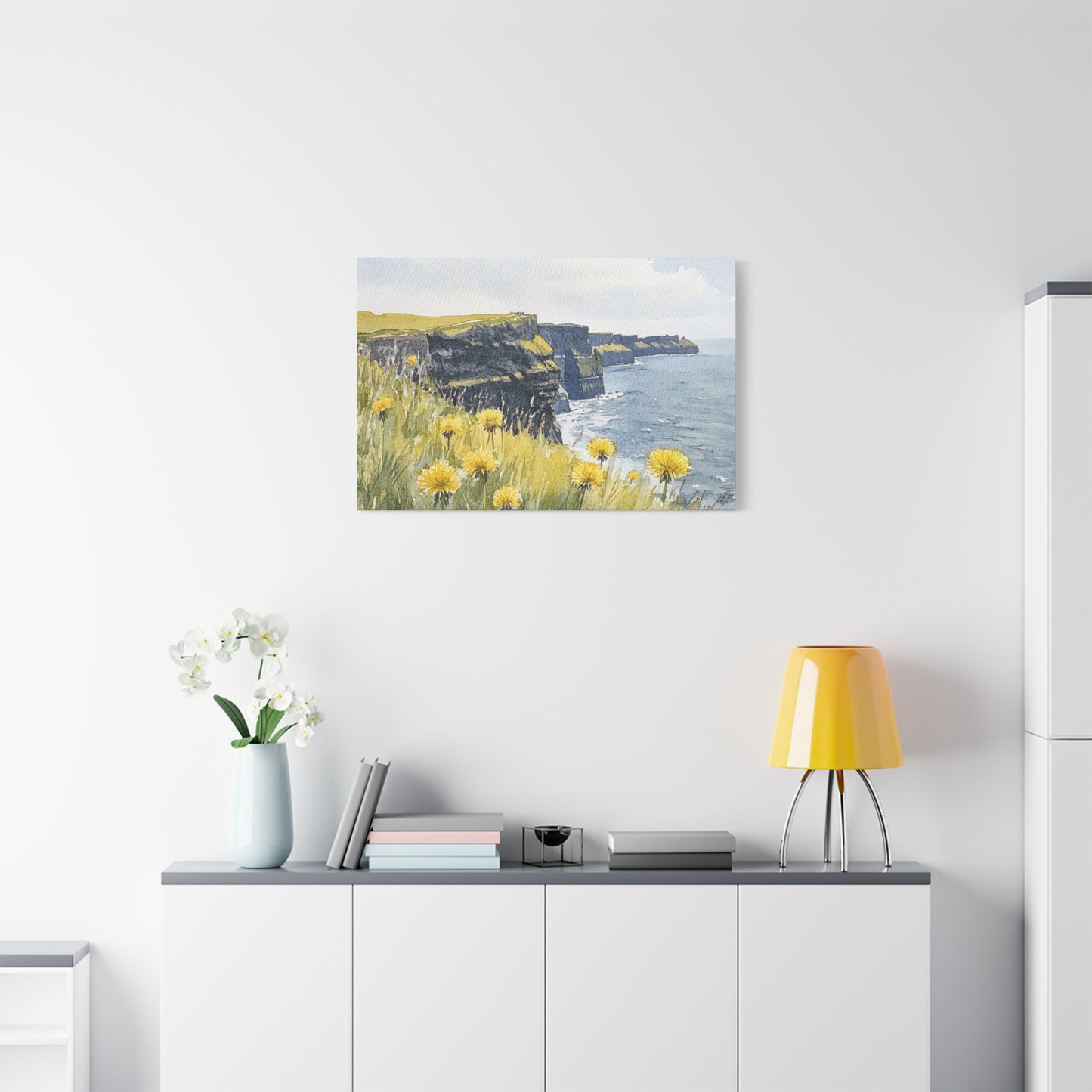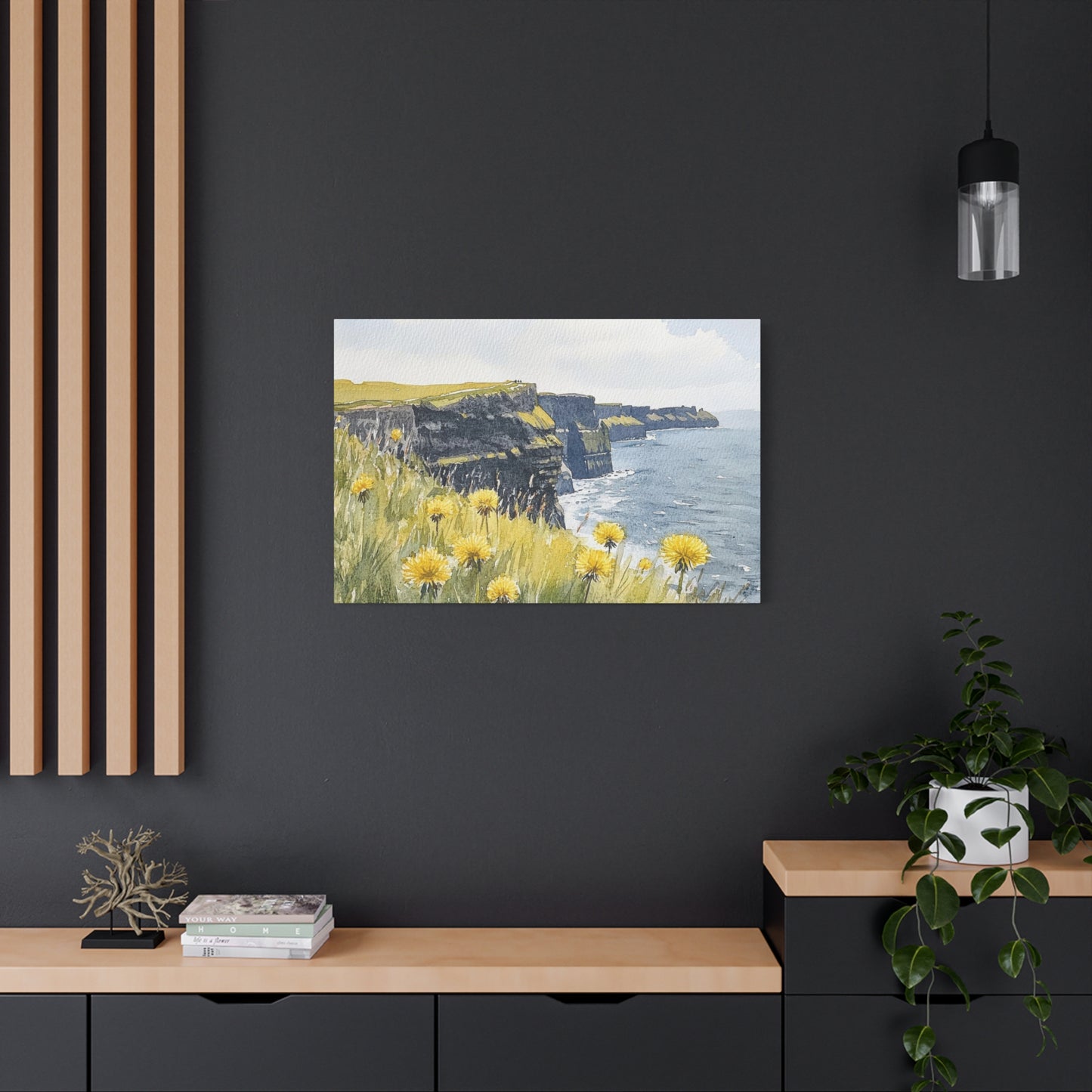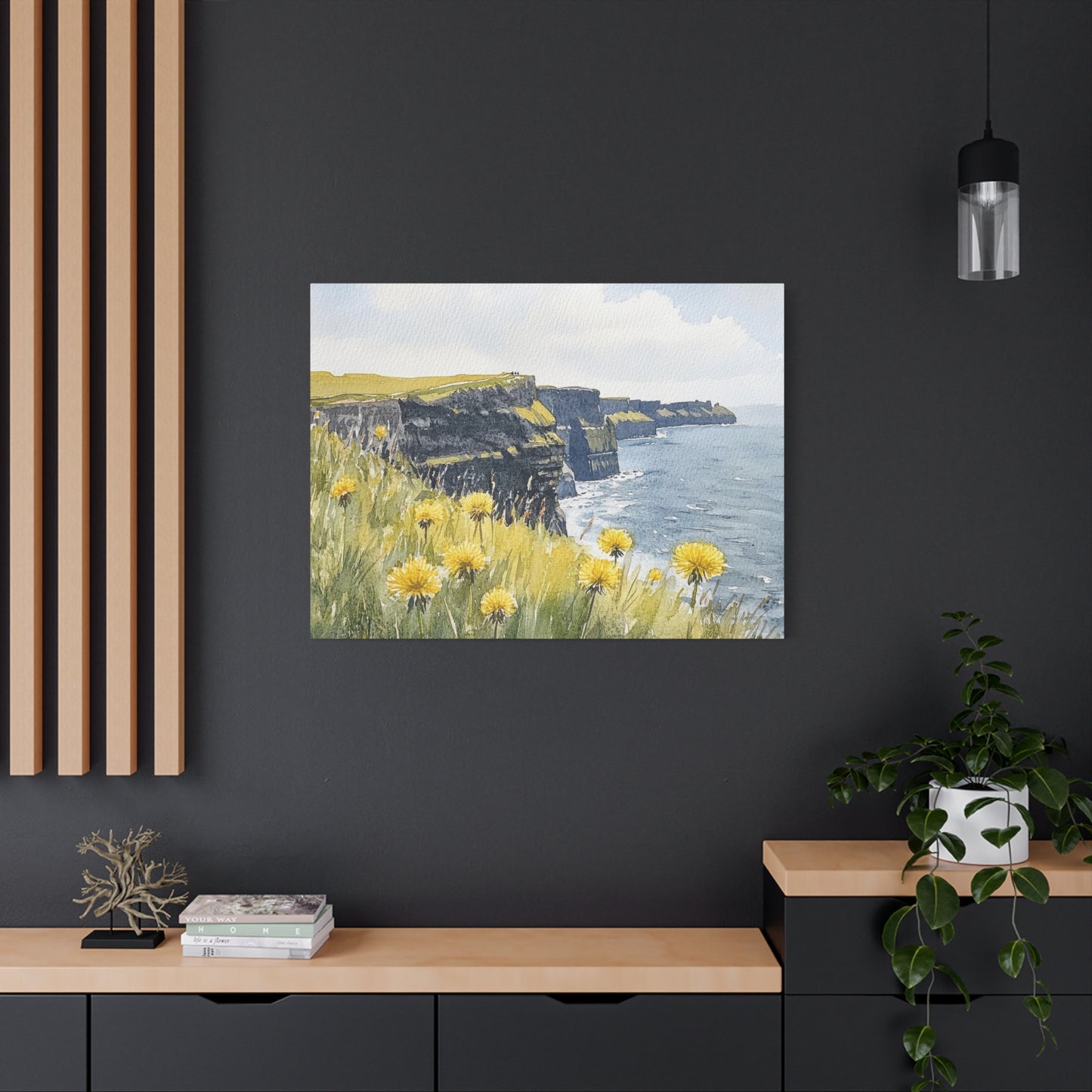Nature’s Majesty on Canvas: Cliff of Moher Ireland Wall Art for Serene Interiors
The rugged coastline of Ireland has captivated visitors and art enthusiasts for centuries, with its dramatic cliffs rising majestically from the turbulent Atlantic Ocean. Among these natural wonders, one location stands out as an iconic symbol of Ireland's raw beauty and untamed spirit. The towering stone formations that guard the western shores have inspired countless artists, photographers, and interior designers to capture their essence and bring that powerful energy into living spaces around the world. This comprehensive guide explores every aspect of incorporating these stunning Irish coastal landscapes into your home through carefully selected canvas prints and wall décor that celebrate the magnificence of Ireland's most visited natural attraction.
Capturing Ireland's Coastal Magnificence Through Canvas Art
The breathtaking vertical rock faces that dominate Ireland's western coastline represent more than just geological formations; they embody the spirit of an entire nation. These ancient stone guardians have witnessed countless storms, sunrises, and sunsets, each moment adding to their mystique and allure. When transformed into canvas art, these powerful landscapes bring an element of nature's grandeur directly into your living environment. The process of selecting the perfect representation of these Irish cliffs for your walls requires understanding both the artistic qualities and the emotional resonance these images carry.
Canvas prints featuring these dramatic coastal scenes offer a unique way to connect with Ireland's natural heritage without leaving your home. The texture of canvas material itself adds depth and dimension to the imagery, creating a tactile experience that flat paper prints simply cannot match. The weave of the canvas catches light differently throughout the day, causing the image to subtly shift and change, much like the actual cliffs transform under varying weather conditions and lighting. This living quality makes canvas the ideal medium for capturing the dynamic nature of coastal landscapes.
The artistic representation of these towering rock formations requires careful consideration of composition, color balance, and perspective. Photographers and artists who specialize in landscape imagery spend countless hours waiting for the perfect conditions to capture these cliffs at their most dramatic. The interplay of light and shadow across the layered stone faces creates natural patterns that draw the eye and engage the imagination. When selecting canvas art featuring these formations, look for pieces that demonstrate this understanding of natural lighting and composition, as these elements will determine how well the artwork integrates into your space and maintains visual interest over time.
The emotional impact of these coastal images extends beyond mere aesthetic appeal. The cliffs represent resilience, permanence, and the awesome power of natural forces. Incorporating such imagery into your living space can serve as a daily reminder of these qualities, creating an atmosphere of strength and stability. The vast scale of these formations, when properly captured and presented, can make smaller rooms feel more expansive while adding gravitas to larger spaces. This psychological dimension of landscape art should not be underestimated when considering how such pieces will affect the overall ambiance of your home.
Transforming Interiors with Irish Landscape Wall Prints
The selection of wall prints featuring Ireland's most famous coastal formations involves understanding how different artistic interpretations can complement various interior design styles. Traditional photography captures the realistic detail and authentic colors of these natural wonders, making them ideal for spaces that celebrate classic aesthetics or geographical authenticity. These photographic prints work exceptionally well in studies, libraries, and formal living areas where their documentary quality adds sophistication and cultural depth. The crisp detail in high-quality photographic prints allows viewers to appreciate the intricate textures of weathered stone, the patterns of erosion, and the various hues present in the rock faces.
Artistic interpretations of these coastal scenes offer alternative approaches for different design sensibilities. Impressionistic renderings can soften the dramatic nature of the cliffs, making them suitable for bedrooms and relaxation spaces where a calmer atmosphere is desired. These interpretations often emphasize color and mood over precise detail, creating pieces that function more as emotional touchstones than geographical documentation. Watercolor-style prints can introduce a dreamy, romantic quality that pairs beautifully with coastal or cottage-style décor, while still maintaining the essential character of the Irish coastline.
Contemporary artistic treatments of these landscapes push boundaries and challenge traditional representations. Abstract interpretations might focus on the geometric patterns within the rock formations, the contrast between stone and sea, or the color relationships present in the natural scene. These modern approaches can make Irish coastal imagery accessible to minimalist and contemporary interiors that might struggle to incorporate traditional landscape art. Bold graphic treatments can transform the recognizable silhouette of these cliffs into striking design elements that serve as focal points in modern spaces.
The scale of your wall prints significantly impacts their effectiveness in transforming a space. Large-scale canvases featuring sweeping panoramic views of the coastline create immersive experiences that can make viewers feel transported to the actual location. These oversized pieces work best as statement walls in spacious rooms with high ceilings, where their full impact can be appreciated. Medium-sized prints offer versatility, working well in dining rooms, hallways, and bedroom spaces where they provide visual interest without overwhelming other design elements. Smaller prints can be arranged in gallery-style groupings to create a curated collection that tells a story about Ireland's coastal beauty through multiple perspectives and compositions.
Designing Living Spaces with Dramatic Coastal Imagery
The integration of powerful landscape imagery into residential interiors requires thoughtful planning and consideration of existing design elements. The color palette present in Irish coastal scenes typically includes deep blues and greens from the ocean, grays and earth tones from the stone formations, and occasional bursts of green from the grass-covered cliff tops. These natural colors provide a foundation that can either harmonize with or provide contrast to your existing décor. Rooms decorated in neutral tones can be dramatically enhanced by the introduction of these rich natural colors, while spaces with existing color schemes can use coastal imagery to tie together disparate elements.
The mood and atmosphere you wish to create should guide your selection of coastal wall art. Images captured during stormy weather, with dark clouds and turbulent seas, evoke drama and power, making them ideal for spaces where you want to create impact and energy. These dramatic pieces work well in entertainment areas, home offices where motivation and focus are desired, or as conversation starters in social spaces. Conversely, images taken during calm, sunny conditions with clear skies and peaceful waters create a sense of serenity and tranquility, making them perfect for bedrooms, meditation spaces, or any area designated for relaxation and restoration.
The architectural features of your space should inform your choices about artwork placement and style. Rooms with large windows and abundant natural light can handle darker, more atmospheric prints without the space feeling heavy or oppressive. The natural light will interact with the canvas surface, bringing out details and creating dynamic viewing experiences throughout the day. Spaces with limited natural light benefit from brighter interpretations of coastal scenes, perhaps those captured during golden hour or featuring more sky than rock formation. The reflective qualities of these lighter images can help distribute available light throughout the room, making the space feel larger and more open.
Furniture arrangement and room function also play crucial roles in successfully incorporating coastal landscape art. In living rooms designed for conversation and gathering, position your Irish coastal canvas where it can be easily viewed from primary seating areas but does not compete with the television or other focal points. Dining rooms benefit from coastal imagery that can be appreciated during meals, providing a sense of escape and conversation material for guests. Bedroom installations should consider sight lines from the bed, ensuring that the first and last images you see each day contribute positively to your mental state and overall well-being.
Exploring Color Palettes in Irish Coastal Canvas Prints
The natural color harmonies present in Ireland's western coastal regions provide endless inspiration for interior design color schemes. The dominant blue-gray tones of the Atlantic Ocean present in these scenes range from deep navy during stormy conditions to bright turquoise in shallow areas near the cliff base. These ocean blues can serve as anchor colors in your room design, informing choices for accent pillows, throw blankets, and other textile elements. The versatility of these blue tones allows them to work with both warm and cool color schemes, making coastal canvas art adaptable to various design aesthetics.
The stone formations themselves display a surprisingly diverse range of colors depending on lighting conditions, time of day, and weather. The layered sedimentary rock shows bands of gray, brown, ochre, and even rust-colored oxidation that create natural striations across the cliff faces. These earth tones provide warmth that balances the cooler ocean blues, creating a naturally harmonious color palette that translates beautifully into interior design. Rooms featuring coastal canvas art can draw on these warm stone colors for furniture choices, wood tones, and accent pieces that echo the natural materials present in the landscape.
The vegetation clinging to the cliff tops introduces vibrant greens that add life and freshness to the color story. Irish coastal grasses range from bright emerald in spring to deeper forest greens in summer, with occasional hints of yellow-green in sunlit areas. These green tones can inspire plant choices for your space, creating connections between the natural world depicted in your art and living elements within your room. The psychological effects of green are well-documented, including stress reduction and eye comfort, making these naturally occurring colors valuable additions to any interior environment.
Sky colors in coastal imagery vary dramatically based on atmospheric conditions and time of capture. Sunrise and sunset images introduce warm peachy pinks, golden oranges, and soft purples that can inspire unexpected and sophisticated color combinations in your décor. Stormy skies bring deep purples, charcoal grays, and dramatic dark blues that create moody, atmospheric environments. Clear day skies contribute bright blues and whites that keep spaces feeling fresh and energetic. Understanding these color variations helps you select coastal canvas art that will either complement your existing palette or inspire a complete room redesign around the natural colors present in Irish coastal landscapes.
Selecting the Perfect Canvas Size for Your Space
Determining the appropriate dimensions for your coastal wall art requires careful measurement and consideration of room proportions. The general rule suggests that artwork should occupy roughly two-thirds to three-quarters of the available wall space above furniture pieces to create visual balance. For a standard sofa measuring seven to eight feet in length, a canvas spanning approximately five to six feet in width creates pleasing proportions. However, these guidelines serve as starting points rather than rigid rules, and personal preference combined with specific room characteristics should ultimately guide your decisions.
Vertical versus horizontal orientation dramatically affects how coastal imagery impacts a space. Horizontal canvases emphasizing the expansive nature of ocean views and the layered composition of cliffs meeting sea work well above sofas, beds, and other horizontal furniture arrangements. These landscape-oriented pieces reinforce the width of a room and can make narrow spaces feel more balanced. Vertical canvases highlighting the towering height of the cliff formations draw the eye upward, making rooms with lower ceilings feel more spacious. These portrait-oriented pieces work beautifully in narrow wall spaces, flanking doorways, or in stairwell areas where vertical emphasis enhances the architecture.
Multi-panel canvas arrangements offer creative solutions for larger wall areas and can create stunning visual narratives. Triptychs featuring different perspectives of the same coastal scene allow viewers to experience the landscape more completely, as if turning their head to take in the full panorama. These three-panel arrangements work particularly well above king-sized beds, large sectional sofas, or as focal points in spacious entryways. Two-panel diptychs create modern, sophisticated presentations that can show contrasting conditions of the same location, such as stormy versus calm seas, or sunrise versus sunset lighting. Five or more panel arrangements create dramatic installations that transform entire walls into immersive coastal experiences.
Room-specific considerations should inform your size selections. In bedrooms, oversized canvas art above the bed should not extend beyond the width of the mattress to maintain balanced proportions. Dining room installations should account for the visual competition from table settings and centerpieces, often benefiting from larger pieces that can hold their own against these elements. Home office spaces benefit from moderately sized coastal images that provide visual relief during work without becoming distracting. Bathroom and powder room installations can feature smaller, more intimate coastal scenes that create moments of escape in these private spaces.
Understanding Print Quality and Canvas Materials
The technical aspects of canvas printing significantly impact the longevity and visual quality of your Irish coastal wall art. Giclée printing represents the gold standard in canvas reproduction, utilizing archival-quality inks and advanced printing technology to create museum-grade reproductions. This process can reproduce incredibly fine details and subtle color gradations that lesser printing methods miss, ensuring that the textures of weathered stone and the subtle color shifts in ocean waters are accurately rendered. Giclée prints resist fading for decades when properly cared for, making them worthwhile investments for serious art collectors and design enthusiasts.
Canvas material composition affects both the appearance and durability of your wall art. Cotton canvas provides a traditional fine art feel with a slightly irregular texture that adds character and authenticity to landscape images. This natural fiber accepts ink beautifully and creates a surface that mimics traditional painted canvases. Polyester canvas offers enhanced durability and resistance to environmental factors like humidity and temperature fluctuations, making it ideal for coastal-themed bathrooms or rooms with significant climate variation. Blended materials attempt to capture the best qualities of both, offering the aesthetic appeal of cotton with improved practical performance.
Canvas weight and thickness influence how well the finished piece maintains its shape and resists sagging over time. Heavier canvases measuring 400 GSM or higher provide substantial feel and exceptional durability, remaining taut on their stretcher bars even in large formats. These premium materials justify their higher costs through superior longevity and professional appearance. Medium-weight canvases around 300 GSM offer good performance for most residential applications at more accessible price points. Very lightweight canvases below 250 GSM may be suitable for smaller prints but can develop issues with larger installations, particularly in humid environments.
Finishing treatments applied to canvas surfaces protect your investment and enhance appearance. UV-resistant coatings prevent sun damage that would otherwise cause colors to fade over time, particularly important for artworks displayed near windows or in brightly lit rooms. Water-resistant treatments provide protection against accidental splashes and make cleaning easier, valuable features for dining room or kitchen installations. Texture-enhancing finishes can add brushstroke-like qualities to photographic prints, creating fine art appearances that blur the line between photography and painting. Understanding these technical considerations helps you select coastal canvas art that will maintain its beauty and impact for years to come.
Creating Gallery Walls with Irish Coastal Themes
The gallery wall approach allows you to create comprehensive visual stories about Ireland's coastal beauty through carefully curated collections of related images. Successful gallery walls balance variety with cohesion, incorporating different perspectives, compositions, and even artistic styles while maintaining thematic unity. For coastal themes, you might combine wide-angle panoramic views showing the full sweep of cliff formations with detailed close-ups of weathered stone textures and intimate captures of coastal wildlife or vegetation. This variety creates visual interest and invites extended viewing as visitors discover new details within your arrangement.
Layout planning determines whether your gallery wall feels intentional and designed or chaotic and overwhelming. Grid arrangements create orderly, sophisticated presentations where uniformly sized and framed pieces align in neat rows and columns. This approach works beautifully in modern and contemporary spaces where clean lines and geometric precision are valued. Organic, salon-style arrangements embrace asymmetry and varied sizing, creating more dynamic and energetic presentations. These eclectic displays suit traditional, bohemian, or eclectic interiors where personality and collected-over-time aesthetics are celebrated. Before committing to wall mounting, arrange your pieces on the floor in your desired configuration and photograph the layout for reference during installation.
Frame selection profoundly impacts the overall effect of your coastal gallery wall. Consistent framing creates unity across diverse images, with all pieces sharing the same frame style, color, and material. Black frames provide classic versatility that works with virtually any image and interior style, allowing the artwork itself to take center stage. Natural wood frames echo the organic qualities of coastal landscapes and work beautifully in rustic, farmhouse, or Scandinavian-inspired interiors. White frames create fresh, gallery-like presentations that feel clean and contemporary. Alternatively, varied framing can add character and collected charm to gallery walls, though this approach requires careful curation to avoid visual chaos.
Spacing and arrangement rhythm influence how viewers' eyes move across your gallery wall. Consistent spacing between all pieces creates calm, predictable patterns that feel restful and organized. Varied spacing with strategic gaps and clusters creates visual interest and can direct attention to particular focal pieces within the arrangement. The center line approach places all pieces along an imaginary horizontal line running through their centers, creating cohesion despite varied sizes. The bottom-aligned or top-aligned method lines up all pieces along one edge, creating strong horizontal emphasis. Consider room-specific viewing patterns when planning placement, ensuring that the arrangement works from primary seating or standing positions within the space.
Incorporating Seasonal Variations in Coastal Wall Art
The changing character of Ireland's western coastline throughout the seasons offers opportunities to refresh your interior environment by rotating coastal artwork. Spring images capture the renewal and vibrancy of coastal ecosystems, with bright green grass covering cliff tops and increased bird activity as seabirds return to nesting sites. These fresher, more optimistic representations of the cliffs work beautifully during the spring months when we collectively seek renewal and new beginnings. The softer light quality typical of spring photography creates gentle, inviting atmospheres appropriate for the season of growth and awakening.
Summer coastal scenes emphasize the dramatic contrast between deep blue seas and the lighter stone colors of the cliff faces under full sun. Long daylight hours allow photographers to capture the coastline during golden hour when warm light illuminates the western faces of the cliffs, creating glowing, almost ethereal images. These bright, energetic representations align with summer's outgoing, active character. The clear atmospheric conditions typical of summer photography create sharp, detailed images that celebrate the magnificence of the landscape in full clarity. These pieces invigorate spaces and connect interior environments with the season's outdoor-focused energy.
Autumn brings moody, atmospheric conditions to the Atlantic coast, with increased storms and dramatic cloud formations creating powerful, emotionally resonant images. The changing colors of coastal vegetation add warm browns and golds to the typical green-blue-gray palette, creating richer, more complex color stories. These transitional images reflect autumn's reflective, harvest-oriented character and work beautifully as we turn inward during cooler months. The dramatic lighting conditions of autumn, with lower sun angles and increased atmospheric phenomena, create coastal images with exceptional depth and mood that add gravitas to interior spaces.
Winter coastal scenes capture the raw power of Atlantic storms battering the ancient cliffs, with massive waves and dark, brooding skies emphasizing nature's might. These dramatic images resonate with winter's introspective, powerful character and create cozy contrast when viewed from warm, protected interior spaces. The reduced color palette of winter photography, often dominated by grays, blues, and whites, creates sophisticated, monochromatic presentations that work beautifully in minimalist or contemporary interiors. The stark beauty of winter coastal scenes reminds us of nature's endurance and our own resilience during challenging seasons.
Matching Coastal Art with Interior Design Styles
Contemporary interiors benefit from clean, minimalist interpretations of coastal landscapes that emphasize form, color, and composition over detailed representation. Large-scale, high-contrast images showing the bold silhouettes of cliff formations against bright skies create striking focal points without introducing visual clutter. Black and white interpretations of the coastline distill the landscape to its essential elements, creating sophisticated artwork that complements the reduced color palettes typical of contemporary design. The strategic placement of a single, substantial coastal canvas maintains the uncluttered aesthetic while providing necessary visual interest and connection to the natural world.
Traditional interiors welcome more classic, realistic representations of Ireland's coastal beauty that honor the documentary tradition of landscape art. Richly detailed photographic prints in substantial wood frames bring Old World sophistication to formal living rooms, libraries, and dining spaces. Multiple smaller coastal scenes arranged symmetrically create balanced, classical compositions appropriate for traditional settings. The natural materials and realistic color palettes in these pieces harmonize with the wood furniture, rich fabrics, and layered accessories typical of traditional design approaches.
Coastal and nautical design themes find natural allies in Irish cliff imagery, with the oceanic focus creating seamless integration. These interiors already incorporate blues, whites, and natural textures, making coastal landscape art feel like essential rather than added elements. The authentic maritime connection of actual coastal photography adds legitimacy and depth to coastal design themes, elevating them beyond mere decorative motifs. Mixing canvas art depicting cliff formations with other coastal elements like driftwood, rope details, and maritime artifacts creates comprehensive, immersive environments that celebrate seaside living.
Rustic and farmhouse interiors embrace the natural, weathered qualities visible in images of ancient stone cliffs. The earth tones present in the rock formations echo the warm wood and natural material palettes central to these design styles. Canvas prints in distressed or natural wood frames integrate seamlessly with the layered, collected aesthetic of farmhouse design. The emphasis on natural beauty over perfection in rustic interiors aligns perfectly with the raw, powerful character of coastal landscape imagery. These spaces benefit from multiple coastal pieces in varied sizes, creating the collected-over-time feel essential to successful rustic design.
Lighting Considerations for Coastal Canvas Displays
Proper lighting transforms coastal wall art from simple decoration into dynamic design elements that evolve throughout the day. Natural daylight creates the most authentic viewing experience, allowing the colors and details in your canvas prints to display as intended. Positioning coastal artwork on walls perpendicular to windows prevents direct sunlight from hitting the canvas while still allowing ambient natural light to illuminate the piece. This arrangement protects your investment from UV damage while ensuring excellent visibility. East-facing walls receive gentle morning light that gradually strengthens, creating evolving viewing experiences as the day begins. West-facing walls catch afternoon and evening light, which can dramatically illuminate coastal scenes as natural light takes on warmer tones.
Artificial lighting requires strategic planning to enhance rather than detract from coastal artwork. Picture lights mounted directly above or below canvas pieces create focused illumination that highlights artwork while adding ambient lighting to the room. LED picture lights offer energy efficiency and produce minimal heat, protecting your canvas from damage while providing excellent color rendering. Track lighting systems allow flexible positioning and direction adjustment, enabling you to create custom lighting solutions for single pieces or gallery wall arrangements. Adjustable heads let you fine-tune the lighting angle to minimize glare while maximizing the visual impact of your coastal imagery.
Accent lighting techniques can create dramatic presentations of coastal wall art that transform the ambiance of entire rooms. Wall-washing techniques use concealed fixtures to create even, glareless illumination across large wall sections, making them ideal for substantial coastal canvases or multi-panel installations. Grazing light directed across the canvas surface from steep angles emphasizes the texture of the canvas weave, adding dimensional interest to the artwork. Backlighting effects, while more complex to install, can create floating appearances for coastal canvases, particularly effective with image selections featuring bright skies or ocean surfaces that seem to glow when lit from behind.
Color temperature of your light sources significantly affects how coastal artwork appears and feels. Warm white lighting around 2700-3000K creates cozy, inviting atmospheres that enhance the earth tones in cliff formations while softening the cooler ocean blues. These warmer temperatures work well in living rooms, bedrooms, and dining spaces where comfort and relaxation are priorities. Cool white lighting around 4000-5000K provides crisp, energetic illumination that emphasizes the blues and grays in coastal scenes while creating alert, focused environments. These cooler temperatures suit home offices, kitchens, and contemporary spaces where clarity and precision are valued. Neutral white lighting around 3500K offers balanced presentation that works well in versatile spaces or rooms used for varied activities throughout the day.
Preserving and Maintaining Coastal Canvas Art
Long-term preservation of your Irish coastal wall art requires understanding and mitigating common threats to canvas longevity. Direct sunlight represents the primary enemy of canvas prints, with UV radiation causing inks to fade and canvas materials to deteriorate over time. Even UV-protected canvases benefit from strategic placement away from direct sun exposure or behind UV-filtering window treatments. If your desired installation location receives significant sunlight, consider applying UV-protective window film or using curtains during peak sun hours to extend your artwork's lifespan. Regularly rotating pieces between high-light and low-light locations distributes exposure and can significantly extend the useful life of your collection.
Environmental conditions within your home affect canvas stability and appearance. Excessive humidity causes canvas materials to expand, potentially leading to warping or sagging on stretcher frames. Dehumidifiers maintain stable conditions in humid climates or damp rooms like basements and bathrooms. Conversely, extremely dry conditions can cause canvas to become brittle and prone to cracking. Humidifiers prevent this deterioration in arid climates or during winter months when heating systems reduce indoor humidity. Maintaining relative humidity between 40-60 percent creates ideal conditions for canvas preservation while remaining comfortable for human occupants.
Regular cleaning maintains the appearance of coastal canvas art while preventing long-term damage from accumulated dust and debris. Soft, dry microfiber cloths gently remove surface dust without scratching or damaging the canvas surface. Light, sweeping motions working from top to bottom prevent dust from being ground into the canvas weave. Compressed air can dislodge dust from textured areas or frame crevices, though care must be taken to use low pressure that won't damage the canvas. Avoid liquid cleaners unless specifically designed for canvas art, as moisture can cause inks to run or canvas materials to deteriorate. If more thorough cleaning becomes necessary, consult professional art conservators rather than risking damage through inexperienced intervention.
Frame and mounting hardware inspection ensures your coastal artwork remains securely displayed. Check mounting brackets and hanging hardware annually for signs of loosening or deterioration, particularly for larger, heavier pieces. Gallery-style wire hangers should be examined for fraying or weakening, with preventative replacement being far preferable to unexpected failure. Stretcher bars maintaining canvas tension should be checked for warping or separation, particularly in environments with significant humidity fluctuation. Corner keys can be carefully adjusted to restore proper canvas tension if slight sagging develops over time. Proper preventative maintenance extends the life of your coastal canvas art indefinitely, allowing these powerful landscape images to grace your walls for decades.
Sourcing Authentic Irish Coastal Photography
The authenticity of coastal landscape photography significantly impacts both artistic quality and ethical considerations surrounding your wall art purchases. Independent photographers who specialize in Irish landscape photography bring deep knowledge of locations, weather patterns, and optimal conditions for capturing these dramatic scenes. Supporting these artists ensures they can continue their work documenting Ireland's natural beauty while providing you with unique, high-quality images unlikely to appear in thousands of other homes. Many landscape photographers maintain portfolios and offer limited edition prints that appreciate in value while adding exclusivity to your collection.
Photography cooperatives and galleries specializing in Irish landscape work provide curated selections that have been vetted for technical quality and artistic merit. These establishments often represent multiple photographers, offering diverse perspectives and styles while maintaining high standards. Gallery purchases typically include certificates of authenticity, information about print runs and editions, and sometimes opportunities to meet the artists. While typically commanding premium prices, gallery purchases provide assurance about image rights, print quality, and artistic legitimacy that budget alternatives cannot match.
The ethics of landscape photography extend to environmental impact and location preservation. Responsible photographers follow leave-no-trace principles, avoiding damage to fragile coastal ecosystems in pursuit of dramatic images. They respect barriers and restricted areas designed to protect both visitors and the environment. Supporting photographers who demonstrate environmental consciousness ensures your wall art doesn't inadvertently contribute to the degradation of the places it celebrates. Many conservation-minded photographers donate portions of their sales to organizations working to preserve Irish natural areas, allowing your purchase to directly support environmental protection.
Reproduction rights and licensing affect both legality and ethics of canvas print purchases. Legitimate vendors operate with proper licenses from photographers or rights holders, ensuring artists receive appropriate compensation for their creative work. Suspiciously inexpensive coastal prints often indicate unauthorized reproduction that deprives artists of earned income while potentially exposing you to legal liability. Verifying that vendors have legitimate rights to reproduce images protects both artists and consumers while supporting sustainable creative economies. The slight premium for properly licensed reproductions represents fair compensation for the skill, time, and equipment investment required to capture these extraordinary images.
Exploring Cultural Significance in Irish Coastal Imagery
The towering cliffs along Ireland's Atlantic coast carry profound cultural meaning extending far beyond their geological and visual characteristics. For centuries, these formations have served as physical and symbolic boundaries between Ireland and the wider world, standing as sentinels against Atlantic storms and representing Irish resilience and endurance. This cultural symbolism adds layers of meaning to coastal wall art, transforming decorative pieces into cultural touchstones that connect your space with Irish heritage and identity. Understanding this deeper significance enriches your relationship with coastal imagery and can inform how you discuss and present these pieces within your home.
Irish literature and folklore are replete with references to these dramatic coastal landscapes, from ancient Celtic mythology to contemporary poetry and prose. Writers have long used these cliffs as metaphors for isolation, endurance, and the relationship between humanity and nature's power. This literary tradition means that coastal imagery resonates on intellectual and cultural levels beyond pure aesthetics, making these pieces particularly appropriate for libraries, reading nooks, and spaces dedicated to contemplation and creativity. The recognition factor of these iconic formations creates immediate connections with anyone familiar with Irish culture, serving as conversation starters and cultural reference points in social spaces.
The cliffs play significant roles in Irish music traditions, appearing in lyrics and inspiring compositions across genres from traditional folk music to contemporary popular songs. This musical connection adds auditory dimensions to visual art, with many viewers reporting that coastal imagery evokes specific songs or musical moods associated with Irish culture. Creating multimedia experiences that combine coastal wall art with curated Irish music playlists can enhance the immersive quality of your space, particularly for themed entertainment areas or during gatherings celebrating Irish heritage. The emotional resonance of combining visual and auditory elements creates powerful, memorable experiences that pure visual art alone cannot achieve.
Contemporary cultural identity in Ireland remains deeply connected to these coastal landscapes, with the formations appearing in tourism campaigns, cultural exports, and national self-representation. This ongoing cultural relevance means that Irish coastal imagery remains contemporary rather than nostalgic, connecting your space to living culture rather than historical artifact. The sustained popularity of these images reflects their ability to communicate essential qualities of place and identity that transcend temporal trends. This cultural staying power suggests that investment in quality coastal artwork represents not just current aesthetic choices but enduring design elements that will remain meaningful and relevant for decades.
Psychological Impact of Coastal Landscape Art
The psychological effects of displaying powerful natural imagery in residential spaces have been extensively studied, with coastal landscapes demonstrating particularly beneficial impacts on mental wellbeing. The biophilic design principle suggests that humans have innate connections to natural environments, and bringing nature imagery indoors satisfies deep-seated psychological needs. Coastal scenes specifically combine multiple beneficial elements including water, which promotes calm and clarity, expansive horizons, which reduce feelings of confinement, and the majesty of geological formations, which evokes awe and perspective. These combined effects make coastal wall art valuable not just aesthetically but therapeutically, contributing to improved mental health outcomes for occupants.
Stress reduction represents one of the most significant psychological benefits associated with natural landscape imagery. Studies demonstrate that viewing nature scenes lowers cortisol levels, reduces blood pressure, and decreases muscle tension associated with stress responses. The mechanisms behind these effects include attentional restoration, where the effortless engagement with natural scenes allows directed attention systems to rest and recover from the fatigue induced by modern life's constant demands. Coastal imagery provides rich visual interest without requiring active cognitive processing, making it ideal for spaces designated for relaxation and recovery from daily stress.
The concept of awe, characterized by the perception of vastness and the need to accommodate experiences that don't fit existing mental frameworks, plays a crucial role in the psychological impact of coastal landscape art. The scale and power evident in images of towering cliffs and endless ocean horizons regularly evoke awe responses in viewers. Research indicates that awe experiences correlate with improved mood, increased feelings of connectedness to something larger than oneself, and enhanced life satisfaction. Regular exposure to awe-inspiring imagery through wall art can provide ongoing psychological benefits, making coastal landscape pieces valuable investments in household wellbeing beyond their decorative functions.
Color psychology interacts with landscape content to create specific psychological effects. The blue tones dominant in ocean and sky imagery promote calm, reduce anxiety, and enhance creativity and communication. These effects make coastal art particularly valuable in bedrooms, where restful sleep is paramount, and in social spaces, where communication and connection are goals. The green tones present in vegetation covering cliff tops provide additional psychological benefits, including stress reduction and eye comfort. The gray tones in stone formations create sophisticated, calming effects while the occasional warm tones from sunset lighting add energy without overstimulation. This naturally occurring, psychologically beneficial color palette makes coastal imagery universally appropriate across residential spaces and design styles.
Creating Themed Rooms Around Irish Coastal Elements
Developing comprehensive Irish coastal themes requires extending beyond wall art to incorporate complementary design elements throughout your space. Textile selections including throw pillows, blankets, and curtains can echo colors from your coastal canvas while introducing textures that reference natural materials. Wool textiles reference Ireland's famous textile traditions while providing cozy warmth appropriate for coastal climate aesthetics. Linen fabrics in natural tones connect to traditional Irish materials while offering lighter, more contemporary feels. Color selection for textiles should draw directly from your canvas art, pulling specific blue, green, gray, or earth tone shades to create cohesive color stories throughout the space.
Furniture choices can reinforce coastal themes through material selection and design aesthetic. Weathered or driftwood-finish pieces reference the natural aging processes visible in coastal environments while introducing organic textures that balance the smooth surfaces of canvas prints. Stone or slate accent pieces echo the geological character of cliff formations, creating material connections between art and functional objects. Glass elements reference water and light interaction while maintaining the clean, uncluttered aesthetic appropriate for coastal-inspired spaces. The goal is creating layers of thematic reinforcement without becoming heavy-handed or theme-park-like in execution.
Decorative accessories provide opportunities for detailed storytelling within your coastal theme. Actual stones or minerals collected from Irish beaches introduce authentic elements that create tangible connections to the landscapes depicted in your wall art. Books about Irish geography, culture, or natural history support the intellectual dimensions of your theme while providing functional reading material. Botanical elements including coastal grasses, heather, or hardy succulents that thrive in rocky, wind-exposed conditions create living connections to cliff-top ecosystems. Map elements showing the western Irish coastline add educational and decorative value while reinforcing geographical specificity.
Lighting fixtures can advance coastal themes through design selection and the quality of light they produce. Fixtures with aged metal finishes or maritime-inspired designs create thematic consistency without resorting to obvious nautical clichés. The choice between warm and cool light temperatures affects how the entire themed space feels, with warmer light creating cozier, more intimate atmospheres and cooler light producing fresher, more energetic environments. Layered lighting incorporating ambient, task, and accent elements ensures your coastal-themed space functions well for varied activities while maintaining atmospheric consistency.
Architectural Considerations for Canvas Installation
Wall construction and composition significantly affect installation possibilities and requirements for coastal canvas art. Drywall over wood studs represents the most common residential wall construction and accommodates standard hanging hardware when properly anchored. Locating studs using electronic finders ensures secure mounting for heavier pieces, with weight distributed across solid framing members rather than relying solely on drywall strength. Plaster walls, common in older homes, require specialized anchors designed for masonry materials to prevent crumbling and provide secure holding power. Understanding your specific wall construction before purchasing hanging hardware prevents installation frustration and potential damage to both walls and artwork.
Ceiling height influences optimal placement for coastal wall art, with standard eight-foot ceilings requiring different approaches than taller spaces. In rooms with standard ceiling heights, canvas art should be positioned so its center falls approximately 57-60 inches from the floor, following the museum-standard eye-level placement. This positioning ensures comfortable viewing without neck strain and creates balanced visual weight within the space. Higher ceilings allow for more vertical installations and can accommodate stacked or vertically-arranged gallery walls that would overwhelm spaces with lower ceilings. Dramatic ceiling heights in two-story entryways or great rooms can showcase oversized coastal panoramas that would be impossible in standard-height rooms.
Architectural features including fireplaces, built-in shelving, and window arrangements create opportunities and constraints for coastal art placement. Fireplace mantels provide natural focal points for coastal canvas installations, with the artwork positioned at appropriate heights above the mantel surface. Built-in shelving can incorporate coastal prints of varied sizes, creating integrated displays that blend art with functional storage and decorative objects. Window placement requires careful consideration to avoid direct sunlight damage while maximizing the ability to view both your canvas art and outdoor views without competition.
Conclusion:
Cliff of Moher Ireland wall art captures the breathtaking majesty of one of the world’s most iconic natural landscapes, transforming interiors into spaces of tranquility, inspiration, and timeless beauty. The rugged cliffs, dramatic ocean waves, and expansive skies of this iconic Irish landmark evoke both awe and serenity, making it an ideal subject for canvas artwork that seeks to balance grandeur with calm. By bringing the natural splendor of the Cliffs of Moher indoors, homeowners and collectors can create interiors that offer a continuous reminder of the power, elegance, and restorative qualities of nature.
At the core of Cliff of Moher-inspired art is the ability to translate raw natural beauty into visual storytelling. Artists often emphasize dramatic contrasts between cliff faces and ocean waves, the interplay of light and shadow, and the expansive depth of the horizon. These elements are captured through a variety of techniques, from realistic depictions to impressionistic and abstract interpretations, allowing each piece to evoke a unique emotional response. The artwork draws the viewer into a moment of reflection, offering both visual stimulation and emotional reprieve, turning even minimalistic interiors into immersive experiences.
From an interior design perspective, Cliff of Moher wall art provides remarkable versatility. Large-scale canvases serve as striking focal points in living rooms, bedrooms, or study areas, immediately establishing a sense of drama and sophistication. Smaller prints or panoramic series can be arranged on gallery walls, creating a layered narrative that guides the viewer’s gaze and enhances spatial depth. The natural color palette—ranging from ocean blues and muted greens to earthy cliff tones and soft skies—harmonizes effortlessly with contemporary, coastal, Scandinavian, and rustic interiors. These tones also allow homeowners to integrate complementary elements such as wooden furnishings, stone textures, and neutral textiles, creating cohesive and serene spaces.
The emotional and symbolic resonance of Cliff of Moher wall art further enriches its appeal. The cliffs symbolize resilience, timelessness, and the natural cycles of life, while the ocean embodies vastness, freedom, and calm. Displaying such artwork fosters mindfulness and a sense of connection to the natural world, encouraging relaxation and introspection. The visual journey from cliff to sea invites contemplation of perspective, balance, and the beauty inherent in both strength and serenity. Whether placed in a private retreat or a shared living space, the artwork cultivates an atmosphere of harmony and thoughtful reflection.
The craftsmanship behind Cliff of Moher canvas prints elevates their transformative potential. Artists employ a range of media, including oil and acrylic painting, watercolor, and high-quality photographic printing, to capture the textures, light effects, and intricate details of the cliffs and surrounding landscape. Some works focus on realistic depictions that emphasize natural beauty and depth, while others explore abstraction or impressionistic styles to highlight mood and atmosphere. This diversity ensures that collectors and homeowners can select pieces that align with personal taste, spatial dynamics, and interior design goals, whether aiming for dramatic focal points or subtle, contemplative accents.
Pairing Cliff of Moher wall art with complementary décor elements enhances the overall impact of a space. Natural materials, such as wood, stone, and linen, reinforce the organic connection to the landscape, while soft lighting—ambient or directional—highlights textures, depth, and tonal variations. Thoughtful placement, whether above a sofa, bed, or console table, ensures the artwork resonates fully, establishing visual balance and a cohesive narrative throughout the room. By integrating the artwork with complementary furniture and accents, the interior becomes a harmonious blend of nature, artistry, and design sophistication.

















